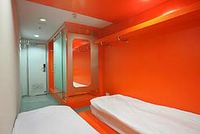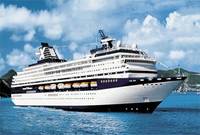.1.jpg)
This article appeared on SPECTRUM ONLINE andout one of Cunard's people that made for great reading:
"
Dale Gardener: The Modern Mariner
The Caribbean is always nice, and the Antarctic is interesting,"
Dale Gardener says. "Funny penguins.
"And the Amazon is quite good; no penguins there, of course, but it's got pink dolphins." Tall, soft-spoken, and British, Gardener is looking back over his 17-plus years with Cunard Line Ltd., of Valencia, Calif., the storied shipping concern, now part of Miami-based Carnival Corp.
As electrical superintendent of Cunard, Gardener oversees the electrical engineers on both the Queen Mary 2, the largest and most technically complex ocean liner ever built, and the Queen Elizabeth 2, the longest-serving ocean liner in Cunard's history.
Gardener epitomizes low-key; it's hard to picture him flustered, even in a job that is equal parts stress and adventure. He does admit to some tense moments during his first shipboard blackout as chief electrical officer on the QE2. "The backup generators come up, and you have to get all the systems up again. Then you have to find out what caused the blackout," he says. "It's normally quite relaxed, but if the blackout goes longer than 5 or 6 minutes, well, passengers start to worry."
The cruise industry is structured like the military, and Gardener climbed the ranks to reach his current position. After serving as a junior electrical officer on the QE2, he moved to chief electrical officer on the smaller Sea Goddess 2, then on to increasingly larger ships before taking on his current position last year.
Before Gardener got his first engineering job with Cunard, he had never been on a ship larger than a three-man sailing dinghy and had never traveled outside the UK. Born in Stourbridge, a small town that is as far as you can get from the sea and still be in England, Gardener attended a two-year technical school, and then went on to an electronics college in northern England, Wray Castle College, in Kendal, for two more years. It would have taken one more year of study to get a full-fledged engineering degree, but Gardener was ready to get to work. (He's now finishing up that degree via correspondence courses.)
When Gardener graduated in 1987, the economy in the UK was not exactly booming, and few companies were recruiting. Cunard, however, had contacted the college with two openings. Three weeks after graduation, he was walking up the gangplank of the QE2 as a junior electrical officer.
The life of a ship's engineer isn't like that of most other engineers. You spend about two months onboard working almost all the time. There are compensations, however. On a full-service passenger ship, you are freed from such mundane chores as cleaning, laundry, and cooking. Even better, crew typically receive about five consecutive weeks off, which you can spend in your home country, as a passenger onboard a ship, or in some exotic port of call. And as you climb the ranks, your shipboard accommodations go up with you. Senior officers on the QE2 get an elegantly furnished bedroom and a sitting room on one of the uppermost decks.
In his first job on the QE2, working under a six-month temporary contract, Gardener was putting in 14-hour days, seven days a week. He did well enough to be offered a full-time job. The QE2 usually traveled trans-Atlantic routes (a role now taken over by her successor, Queen Mary 2), often with such luminaries as Mick Jagger or David Bowie aboard. His favorite route was the world cruise, visiting New York City, the Caribbean, the Panama Canal, Mexico, Hawaii, Australia, Hong Kong, Thailand, Japan, South Africa, the Mediterranean, and back to the UK.
Though his second ship, the Sea Goddess 2, was much smaller, the move to chief electrical officer was a huge jump in status and responsibility. This ship typically carried 100 passengers on chartered Mediterranean voyages, and Gardener even attended the 1992 Barcelona Olympics, in Spain, when the Sea Goddess 2 was docked there as home for the Australian Olympic team. From the Sea Goddess 2, he moved to the Cunard Princess, also cruising the Mediterranean, then to the Cunard Sagafjord, a midsize ship that accommodated 600 passengers.
It was on the Sagafjord that he visited the Antarctic with an expedition team and film crew led by Jean-Michel Cousteau. The group had permits to land the expedition team on shore. Gardener and his engineering team stayed onboard, wrestling to get clean transmissions from the video cameras to shipboard displays so that passengers could view the local wildlife from the comfort of the ship.
After the Sagafjord, he returned to QE2, this time as chief electrical officer. Last year, he moved to Miami as electrical superintendent for the entire Cunard Line, then to Valencia when Cunard's headquarters was relocated.
On Queen Mary 2 and QE2, the most famous vessels in the cruise industry, the technical challenges are not just about keeping shipboard systems going. Queen Mary 2 itself is a triumph of electrical engineering, propelled by four 21.5-megawatt electric motors driven by electric generators that are in turn spun by diesel engines. The motors are mounted in huge pods beneath the ship; two of the pods move to change the ship's heading. The vessel is outfitted with computer controls that consult with Global Positioning System receivers to continually adjust the orientation of the pods. The huge ship is as much high-tech city as floating test bed. "We have huge amounts of equipment that have the serial number 1," Gardener says. He was involved in an early test of satellite communications for Comsat International, in McLean, Va., in the late 1980s, in several attempts to test interactive television in the early 1990s, and in the change from steam turbines to diesel-electric engines in 1987.
Gardener's work isn't always at sea. In 2003 he spent six months in Venice, Italy, supervising the installation of electrical systems on a ship that was to be Cunard's Queen Victoria but will now be P&O Cruises' Arcadia. (P&O, a sister cruise company based in Southampton, England, is also owned by Carnival.) He drew on his own blackout-recovery experiences to help redesign the power management systems. In the future, engineers on this ship will better be able to diagnose a blackout because the power network will automatically split itself into pieces after a failure, to isolate the problem.
Now in Valencia, he's busy unpacking boxes in his new office at Cunard's headquarters. One current challenge is investigating the possibility of putting in a complete cellphone system on Queen Mary 2 so that passengers will be able to use their own cellphones or a rented phone to call anywhere in the world through a satellite relay.
After 17 years on ships, Gardener was ready to try living on shore. "But I still get to spend time with the ships," he says, "so this job is ideal." "

.jpg)


.jpg)





.1.jpg)
.jpg)
.jpg)
.1.jpg)

